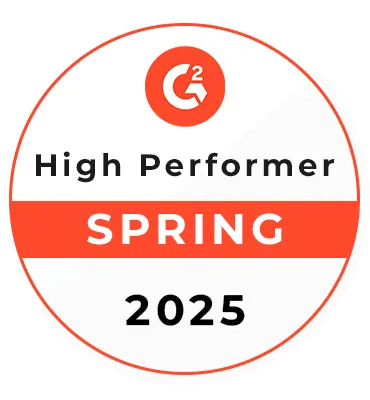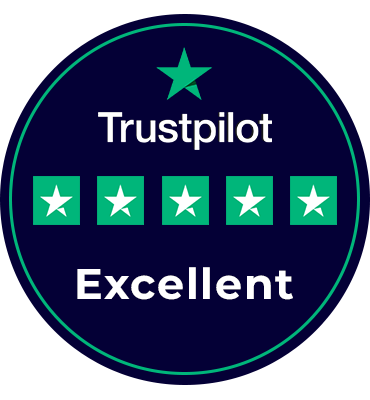Guide to Effective Product Catalog Management for Manufacturing Websites
Manish Kumawat
Last Updated on: 09 July 2025
What will you feel if you visit a showroom packed with advanced equipment, but the lights are off and the descriptions are written in code or an unknown language? That's what an outdated product catalog feels like. But, when you offer an attractive product catalog, you are halfway to profitable deals.
A well-managed product catalog is the heart and soul of any manufacturing company's website. However, creating a product catalog that genuinely shines requires more than just listing product names and pricing. Here we go into the most important methods and best practices for managing your manufacturing website's product catalog and the role of a website development company in this process.
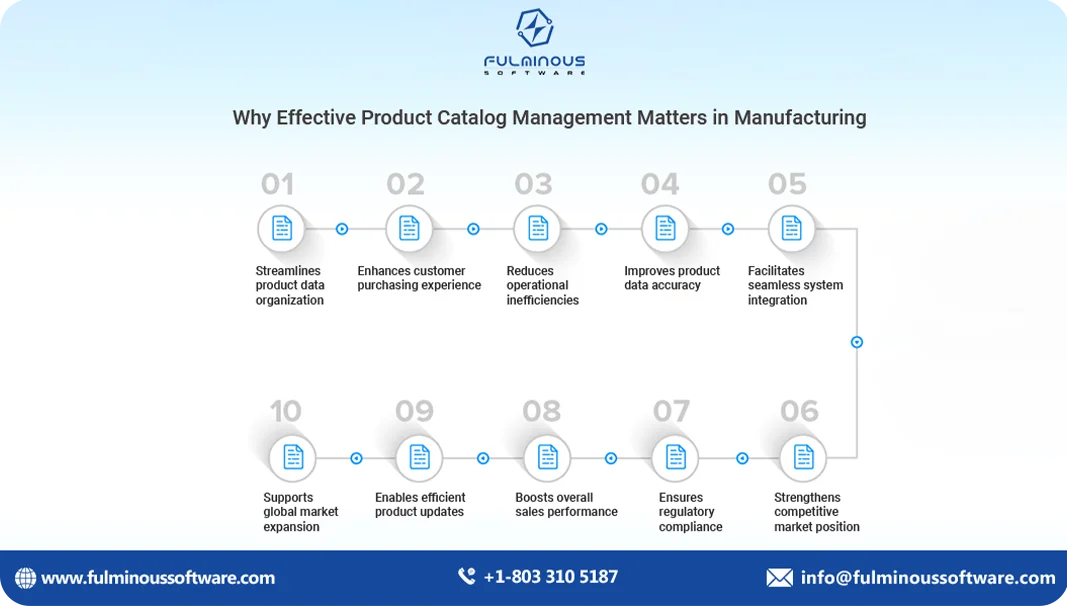
Let’s Begin by Understanding Product Catalog Management
Product catalog management involves organizing, maintaining, and updating your product information in a way that is both user-friendly and efficient. It encompasses various tasks, including:
- Data Entry and Organization: Ensuring all product details are accurately entered and categorized.
- Data Enrichment: Adding high-quality images, detailed descriptions, and specifications.
- Inventory Management: Keeping record of stock counts and availability.
- Pricing Management: Updating prices to reflect changes in cost, discounts, or market trends.
- Product Lifecycle Management: Managing products from introduction to discontinuation.
See the Power of a Well-Managed Product Catalog
Why should you invest time and resources into crafting a stellar product catalog? Here are the compelling benefits:
- Best Customer Experience: A well-organized and informative catalog makes it easy for visitors to find the products they need. Clear descriptions, high-quality images, and relevant specifications eliminate confusion.
- Maximum Visibility: The strategic use of keywords and proper categorization helps search engines understand what you offer. Your product catalog will improve your website's ranking in search engine results and potential customers can easily discover your products.
- Increase Sales Conversions: A well-managed catalog not only attracts visitors but also converts them into buyers. Compelling product descriptions, engaging visuals, and clear calls-to-action (CTAs) encourage visitors to learn more, compare options, and ultimately, make a purchase.
- Premium Brand Image: A professional, well-maintained product catalog demonstrates your attention to detail and devotion to quality. When you describe like this, you make a good impression on potential customers by demonstrating your professionalism in the manufacturing field.
- Smooth Internal Processes: A structured and effective product catalog management system will help your internal operations. It saves your team significant time by lowering product information inaccuracies and speeding up order fulfillment.
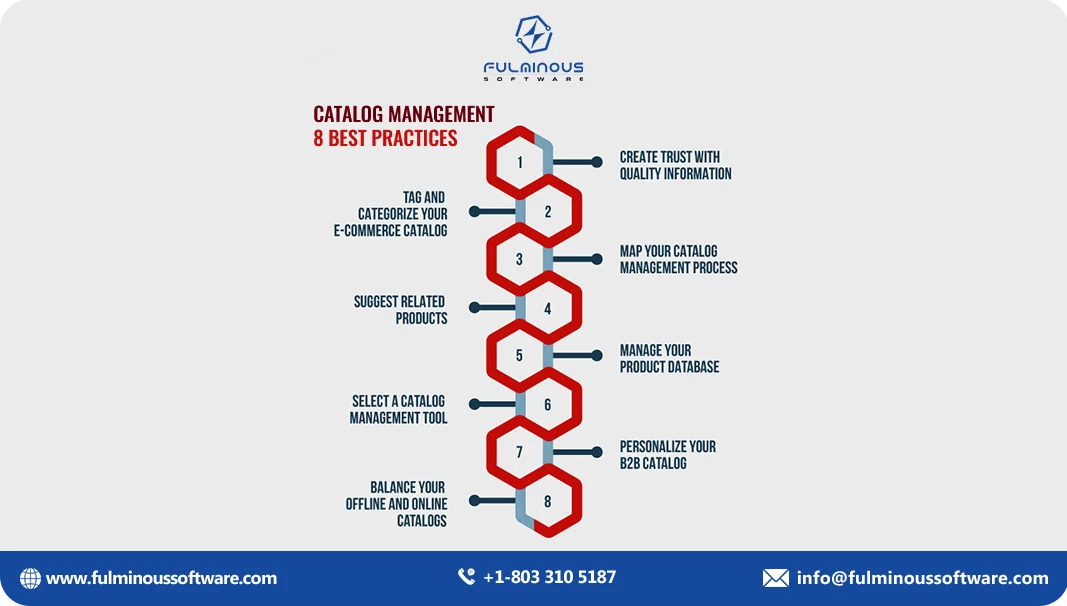
Building a Winning Product Catalog Management Strategy
1. Define Your Goals and Target Audience:
Before creating a catalog, consider the major objectives of your website.
- Is it generating leads, increasing online sales, or raising brand awareness?
- Who is your ideal customer?
- Identifying your target audience allows you to personalize product information to their specific requirements and interests.
2. Choosing the Right Platform
Selecting the right platform for your product catalog is the first step. Look for a Content Management System (CMS) or e-commerce platform that offers robust catalog management features. Popular choices include:
- Shopify: Popular for its smooth and extensive app environment.
- Magento: Offers powerful customization options and scalability.
- WooCommerce: Ideal for WordPress users, offering flexibility and control.
3. Gather and Organize Your Product Information:
Compile all the vital details about your products. This includes:
- Product Names and Descriptions: Use clear, concise, and engaging language that accurately describes the product's features, benefits, and applications.
- Specifications and Technical Data: Provide detailed technical specifications for customers who require precise information.
- High-Quality Images and Videos: High-resolution product visuals are crucial. Showcase your products from various angles and consider including interactive 360° views or informative videos. Get assistance from skilled UI/UX designers!
- Downloads and Resources: Offer downloadable product manuals, data sheets, or CAD drawings for further information.
- Category and Subcategory Organization: Create a logical and intuitive categorization system for easy navigation and browsing.
4. Structuring Your Catalog
A well-structured catalog is easy to navigate and helps customers find what they're looking for quickly. Consider the following:
- Categories and Subcategories: Arrange and categorize products logically. For example, if you manufacture industrial equipment, the main categories could be "Machinery," "Tools," and "Accessories," with subcategories for specific types.
- Attributes and Filters: Define product attributes (e.g., size, color, material) to enable filtering and sorting.
- Consistent Naming Conventions: Use clear, concise, and consistent names for products and categories.
5. Enriching Your Product Data
- High-Quality Images: Images are crucial for online shopping. Ensure each product has multiple high-resolution images from different angles.
- Detailed Descriptions: Write compelling and informative product descriptions. Highlight key features, benefits, and use cases. Use bullet points for easy readability and include technical specifications for those who need detailed information.
- Customer Reviews and Ratings: Integrate clients reviews and ratings into your manufacturing product pages. Motivate happy customers to share reviews and replay to feedback.
6. Optimizing for Search Engines (SEO)
- Keyword Research: Identify the keywords your targeted customers are using to search for your products.
- On-Page SEO: Optimize your product pages by incorporating keywords into:
- Titles: Use primary keywords in product titles.
- Descriptions: Naturally include keywords in product descriptions.
- Meta Tags: Write attractive meta descriptions and include top-ranking keywords.
- URLs: Make sure URLs are clean and include top-ranking keywords.
- Schema Markup: Implement schema markup to help search engines understand your product information better.
7. Managing Inventory and Pricing
- Real-Time Inventory Management: Use a real-time inventory management system to keep track of stock levels.
- Dynamic Pricing Strategies: Implement dynamic pricing strategies to remain competitive. Monitor market trends, competitor prices, and adjust your prices accordingly.
8. Enhancing User Experience
- Intuitive Navigation: Ensure your website's navigation is intuitive. Use breadcrumb trails, clear menus, and a search bar to help users find products easily.
- Mobile Optimization: With the increasing use of mobile devices for online shopping, ensure your product catalog is mobile-friendly.
- Leverage the Power of Technology: Consider using a Product Information Management (PIM) system.
9. Prioritize Keyword Optimization:
- Incorporate relevant keywords throughout your product descriptions, titles, and meta tags.
- Avoid keyword stuffing as it can negatively impact user experience and website ranking.
10. Embrace Compelling Content:
Beyond technical details, consider adding compelling content to your product catalog. This could include:
- Customer Testimonials and Case Studies: Showcase how your products have benefited other customers by including testimonials and real-world applications.
- Informative Blog Posts: Create blog posts related to your products, detailing their applications, benefits, or industry trends.
11. Monitoring and Analytics
- Tracking Performance Metrics: Use analytics tools to track key performance metrics such as:
- Conversion Rate: The proportion of visitors who complete a purchase.
- Bounce Rate: The number of users that quit after viewing only one page.
- Average Order Value (AOV): The normal cost per order.
- Conduct regular audits to identify and address issues such as outdated information, broken links, or poor-performing products.
12. Analyze and Optimize:
- Track how visitors interact with your product catalog.
- Use analytics tools to identify popular products, understand user behavior, and continuously optimize the catalog for better engagement and conversions.
Advanced Technologies for Product Catalog Management on Your Manufacturing Website
1. The PIM Powerhouse:
Ever heard of a PIM system? It stands for Product Information Management, basically a fancy name for a software superhero that helps you manage all your product data in one place. Think of it like your digital filing cabinet – organized, efficient, and way cooler than those overflowing folders in your office.
A PIM system lets you update product details, descriptions, and images across your entire website (and other platforms) with a few clicks. No more struggling with copy-pasting or worrying about outdated information.
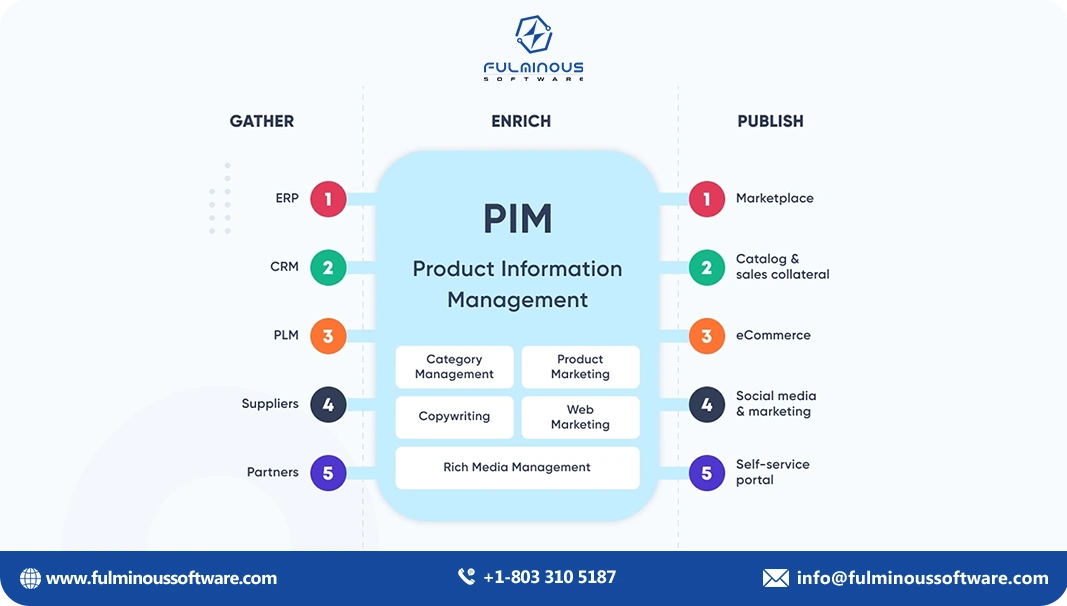
2. AI, Your New Catalog Assistant:
Artificial Intelligence (AI) isn't just for robots in sci-fi movies anymore.
- Automatic Tagging: Imagine AI magically attaching relevant keywords to your product descriptions, making it easier for potential customers to find your offerings in search engines. It's like having a super-powered SEO buddy working behind the scenes!
- Personalized Recommendations: AI can analyze user behavior and recommend products based on previous searches or purchases. This personalization makes your catalog feel like a friendly salesperson.
- Chatbots: Your 24/7 Sales Assistant: Ever wished your sales team could be available 24/7 to answer customer questions? AI-powered chat programs can answer basic inquiries about your products, guide customers through your catalog, and even handle simple transactions. Think of them as friendly robots working overtime to provide excellent customer service, even when your team is off the clock.
3. Augmented Reality (AR) Takes Center Stage:
Want to give potential customers a taste of your products before they buy? Enter AR, the trending technology that overlays digital content onto the real world. Think of it like a magic trick – customers can use their smartphones or tablets to view 3D models of your products in their workspace, seeing how they fit and function.
4. Embrace the Power of 360° Views:
Forget blurry product photos that leave more questions than answers. 360° product views allow customers to explore every angle of your offerings, just like they would in a physical store. 360° product views give them a better understanding of the product and increase their trust. Imagine being able to virtually rotate a valve or zoom in on the intricate details of a machine – that's the power of 360° views!
5. Integration with ERP Systems
Integrate your product catalog with your Enterprise Resource Planning (ERP) system. Enterprise Resource Planning (ERP) system ensures seamless data flow between your website and back-end systems.
What is Catalog Management Software?
Imagine you're having a big online store. You've got tons of products: clothes, electronics, toys, everything! How do you keep track of all the details about each item? That's where catalog management software comes in.
It's like a digital organizer for your products. You can add pictures, descriptions, prices, and even special offers. It helps you keep everything organized and up-to-date, so your customers always see the right information. Think of it as your store's digital catalog!
Common Challenges in Product Catalog Management and Strategies to Overcome Them
Product Catalog Management of manufacturing business always face several challenges. But each of them have certain solutions also.
| Challenge | Description | Solution |
|---|---|---|
| Data Inconsistency | Inconsistency in product data across different platforms and sources. | Implement a centralized data management system with real-time synchronization. |
| Complex Product Information | Managing and presenting detailed product specifications and variants. | Use a robust Product Information Management (PIM) system to handle complex product data. |
| Frequent Product Updates | Keeping the catalog up-to-date with new products, discontinued items, and changes in specifications. | Establish automated workflows for product updates and regular audits of catalog data. |
| Poor Data Quality | Inaccurate, incomplete, or outdated product information. | Conduct regular data quality checks and validations. Provide training for data entry staff. |
| Inefficient Search and Navigation | Due to poor search functionality, users feel difficulty in finding specific products. | Optimize search algorithms. Implement advanced filtering options. |
| Lack of Integration | Disconnected systems leading to manual data entry and errors. | Integrate catalog management with ERP, CRM, and other business systems. |
| Scalability Issues | Scaling the catalog is difficult as the product selection expands. | Choose scalable catalog management software and plan for future growth. |
| User Experience (UX) Problems | Poorly designed catalog interface leading to user frustration. | Invest in UX design. Regularly gather user feedback to improve the interface. |
| Multilingual and Multiregional Catalogs | Managing catalogs in multiple languages and regions. | Use a PIM system that supports multilingual and multiregional data management. |
| Regulatory Compliance | Verify that the catalog follows industry standards and laws. | Stay updated with regulations. Implement compliance checks within the catalog system. |
| Product Lifecycle Management (PLM) | Managing products from introduction to discontinuation effectively. | Implement a PLM system to track. Manage the entire product lifecycle. |
| Customer Feedback Integration | Incorporating customer reviews and feedback into the catalog. | Set up a system for collecting and displaying customer feedback in the catalog. |
Let’s see How it works!
Case Study 1: Acme Industrial - Breathing Life into B2B Products
Acme Industrial, a leading manufacturer of industrial valves, faced a challenge: their website product catalog was dry, technical, and failed to engage potential customers. The catalog relied on text descriptions and lacked visuals, making it difficult for engineers and procurement specialists to understand the full value proposition of each valve.
Solution: Acme implemented a multi-pronged approach to revitalize their product catalog:
- Visual Storytelling: High-quality product photos showcased the valves from various angles, with close-ups highlighting key features.
- Enhanced Content: Technical specifications were accompanied by infographics and video demonstrations, explaining the valves' functionality and operational benefits.
- Targeted Content: Recognizing their diverse audience, Acme created downloadable white papers and case studies tailored to specific industries and applications of their valves.
- Improved Search Functionality: The product catalog was reorganized with clearer categories, subcategories, and advanced filtering options based on technical parameters.
Results: Within three months, Acme saw a 35% increase in website traffic and a 20% rise in qualified leads generated through their product catalog.
Case Study 2: GreenTech Solutions - Simplifying Complex Products for Consumers
GreenTech Solutions, a manufacturer of solar panels and home energy systems, aimed to increase online sales through their website. They realized their product catalog, while informative, overwhelmed consumers with technical jargon and complex installation details.
Solution: GreenTech focused on simplifying their product catalog for the everyday consumer:
- Interactive Calculators: They incorporated online calculators that allowed users to estimate their energy needs and recommend the optimal solar panel system for their homes.
- Customer Story Videos: GreenTech showcased real customers who had transitioned to solar energy, highlighting the benefits and ease of installation through compelling video testimonials.
- Financing Options: The product catalog integrated information about available financing options, making it clear and easy for customers to understand the affordability of solar energy solutions.
- Customer Support Integration: A prominent live chat feature was added to the product pages, allowing customers to connect with support representatives and address any questions before making a purchase.
Results: GreenTech saw a 40% increase in online sales of solar panel systems within six months. Consumer feedback highlighted the user-friendliness of the catalog and the valuable resources provided helped them make proper purchasing decisions.
Case Study 3: From Complex to Conversion: Medical Tech Inc. Simplifies Their Catalog
Challenge: Medical Tech Inc., a manufacturer of medical diagnostic equipment, faced a challenge. Their product catalog, while comprehensive, was filled with technical difficulties and complex product descriptions. The complex product catalog led to loss of potential customers, leading to high bounce rates and missed conversion opportunities.
Solution: Medical Tech Inc. revamped their product catalog with a focus on clarity and user experience:
- Simplified Descriptions: They replaced technical jargon with clear, concise language that explained product features and benefits in easy-to-understand terms.
- Interactive Patient Journey Videos: Short, engaging videos showcased how their equipment was used in clinical settings.
- Doctor Testimonials: Medical Tech Inc. incorporated video testimonials from doctors who used their equipment, emphasizing improved diagnostic accuracy and patient outcomes.
Results: Within six months, Medical Tech Inc. observed a 15% decrease in website bounce rates. More significantly, they achieved a 20% increase in qualified leads generated through online inquiries from potential customers.
Why to Hire Fulminous Software Experts to Assist You in Effective Product Catalog Management
For all the above-mentioned tasks, you need the help of a certified and experienced tech partner. But don't worry, Fulminous Software is here!
Here's why you should choose Fulminous Software to be your product catalog partner:
- User-Friendly Focus: Our Web Design team design a catalog that's as easy to navigate as your favorite website, keeping customers happy and finding products fast.
- Tech Expertise: Forget manual updates! We use trending tools like automatic data refreshers and AI product recommenders.
- Results-Driven: We prioritize happy customers leading to increased sales, plus save your team time with organization and updates.
- Full Support: We guide you through every step, from clear descriptions to implementing the latest technology – no tech expertise needed!
- Industry Knowledge: We understand the complexities of manufacturing and translate that into effective catalog creation.
- Focus on Conversions: Our goal is to transform your catalog from an information dump into a powerful sales tool.
- Streamlined Processes: We help you leverage technology to automate tasks and optimize catalog management.
- Affordable Expertise: You don't need to break the bank to get a top-notch product catalog.
- Long-Term Partnership: Fulminous Software isn't just a one-time fix. We're committed to maintaining a long-lasting relationship with your manufacturing business.
- Transparency Every Step of the Way: We believe in clear communication and open collaboration.
- Scalable Solutions: Our website development and related solutions can grow your business, ensuring your catalog remains effective regardless of expansion.
- Dedicated Partnership: We're your one-stop shop for transforming your product catalog into a sales champion.
Conclusion
Effective product catalog management is a cornerstone of a successful manufacturing website. Your product catalog has to be an updated manual. With the above-described helpful tips, you can convert it into a profitable sales machine. From clear descriptions to interesting tech tools, you've got everything you need to build a catalog that turns visitors into consumers. Remember, a well-managed catalog is an investment in your company's future, so don't put it off any longer - start developing your sales champion today! You may improve the user experience, speed up processes, and increase sales by carefully organizing, enhancing, and optimizing your catalog.
Ready to transform your product catalog into a sales machine? Contact us today to learn more about how we can help you create an optimized, user-friendly catalog that drives results. Call us at +1 903 488 7170 or write to us at info@fulminoussoftware.com.
FAQs
- Q1: What is product catalog management?
- A: Product catalog management involves organizing, maintaining, and updating product information to ensure accuracy, usability, and efficiency.
- Q2: Why is a well-managed product catalog important?
- A: A well-managed catalog enhances customer experience, increases visibility, boosts sales conversions, and improves brand image.
- Q3: What platforms are recommended for product catalog management?
- A: Popular platforms include Shopify, Magento, and WooCommerce for their robust catalog management features.
- Q4: How can high-quality images improve my product catalog?
- A: High-quality images showcase products clearly, enhance visual appeal, and provide detailed views that help customers make informed decisions.
- Q5: How can AI enhance my product catalog?
- A: AI can personalize product suggestions, improve search accuracy, and enhance overall user experience through machine learning.
- Q6: How can customer reviews impact product sales?
- A: Customer reviews and ratings provide social proof, influencing potential buyers and boosting credibility.
- Q7: What is exactly a Product Information Management (PIM) system?
- A: A PIM system centralizes and manages product data, automating tasks and ensuring consistency across all channels.
HIRE A TOP SOFTWARE DEVELOPMENT COMPANY

 Verified
Expert in Software & Web App Engineering
Verified
Expert in Software & Web App Engineering
I am Manish Kumawat, co-founder of Fulminous Software, a top leading customized software design and development company with a global presence in the USA, Australia, UK, and Europe. Over the last 10+ years, I am designing and developing web applications, e-commerce online stores, and software solutions custom tailored according to business industries needs. Being an experienced entrepreneur and research professional my main vision is to enlighten business owners, and worldwide audiences to provide in-depth IT sector knowledge with latest IT trends to grow businesses online.
Partner with Top-Notch Web Application Development Company!
Discuss your Custom Application Requirements on info@fulminoussoftware.com or call us on +1-903 488 7170.
15 Days Risk-Free Trial
